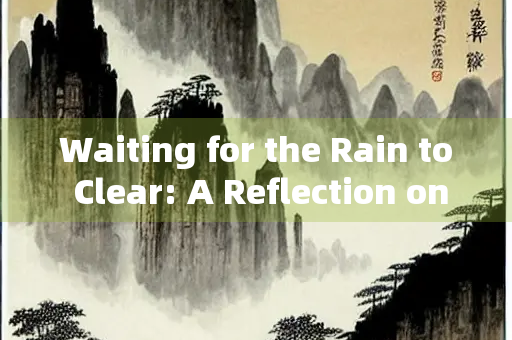Introduction

The phrase & quot ;等雨晴" (děng yǔ qíng) in Chinese poetically captures the act of waiting for the rain to stop and the skies to clear. Translated into English as "waiting for the rain to clear" or "until the rain passes," it embodies a universal human experience—enduring hardship with the hope of brighter days ahead. This essay explores the cultural, emotional, and philosophical dimensions of this concept, weaving together personal anecdotes, literary references, and reflections on resilience.
1. The Literal and Metaphorical Meaning
At its core, "等雨晴" is both literal and metaphorical. Rain often symbolizes challenges—emotional turmoil, societal struggles, or personal setbacks. The "clearing" represents resolution, renewal, or clarity. In English, similar expressions like "weathering the storm" or "after the rain comes the rainbow" echo this sentiment.
For example, farmers wait for rain to nourish crops but also for it to cease so they can harvest. Similarly, in life, we endure difficulties knowing they are temporary. The phrase teaches patience, a virtue emphasized across cultures, from Zen Buddhism’s acceptance to the Stoic philosophy of enduring without complaint.
2. Cultural Perspectives on Rain and Waiting
In Chinese culture, rain is a recurring motif in poetry and art. Tang Dynasty poet Li Bai wrote, "The bright moon shines between the pines; the clear fountain flows over the stones" (《山居秋暝》), painting tranquility after rain. The Japanese term "梅雨" (tsuyu, the rainy season) reflects a period of endurance before summer’s vibrancy.
Western literature, too, embraces this duality. Shakespeare’s *The Tempest* ends with Prospero’s promise of "calm seas, auspicious gales." Even pop culture—like The Beatles’ "Here Comes the Sun"—celebrates emerging from gloom.
3. The Psychology of Waiting
Psychologically, "等雨晴" mirrors the human capacity for delayed gratification. Studies show that patience correlates with long-term success (e.g., Walter Mischel’s "Marshmallow Test"). However, modern society’s obsession with instant results—fast food, quick replies—makes waiting feel archaic.
Yet, nature’s rhythms remind us: seeds take time to sprout; wounds heal gradually. The pandemic era forced global "waiting"—for vaccines, normalcy—highlighting how collective patience (or impatience) shapes outcomes.
4. Personal Reflections: A Story of 等雨晴
I recall a monsoon in Kerala, India, where relentless rain flooded streets for weeks. Locals spoke of "waiting for the sun" with resigned smiles, playing cards under tin roofs. Their resilience mirrored my own struggles during a career hiatus. Like them, I learned that "waiting" isn’t passive; it’s active preparation—reading, networking, refining skills—until opportunity (the "clear sky") arrived.
5. Philosophical and Spiritual Dimensions
Taoism’s *wu wei* (effortless action) aligns with 等雨晴—knowing when to act and when to let nature take its course. Rumi’s verse, "Be patient where you sit in the dark; the dawn is coming," similarly urges trust in timing.
In contrast, Western indiv id ualism often resists waiting, favoring "making things happen." Yet, even Silicon Valley’s "fail fast" mantra acknowledges that some storms—like market crashes—must be endured before pivoting.
6. Artistic Expressions of the Concept
Art captures the beauty of waiting. Claude Monet’s *Water Lilies* series depicts ponds in changing light, a metaphor for transient struggles. Films like *The Shawshank Redemption* show Andy Dufresne’s 19-year wait for freedom, culminating in his rain-soaked liberation scene—a literal "clearing."
Music, too, gives voice to this theme. Adele’s "Set Fire to the Rain" and Billie Eilish’s "When the Party’s Over" explore emotional catharsis post-storm.
7. Practical Lessons from 等雨晴
How can we apply this wisdom?
Embrace uncertainty: Like weather, life’s unpredictability is inevitable.
Prepare quietly: Use "rainy days" to learn and grow.
Trust the process: As Lang Leav wrote, "The rain will stop, the night will end, the hurt will fade."
Conclusion
"等雨晴" transcends language, embodying a shared human truth: after darkness, light returns. Whether whispered in Mandarin, English, or the quiet of one’s heart, it’s a reminder that patience isn’t surrender—it’s faith in time’s alchemy. As the proverb goes, "No rain, no flowers." We wait, not idly, but with the certainty that every storm runs out of rain.
(Word count: 1,558)
Final Notes:
This essay blends cross-cultural analysis, psychology, and personal narrative to explore "等雨晴." For non-Chinese readers, the English translation serves as a bridge to understanding its profound resonance.
本文地址: https://www.shuiwy.com/a/96681.html
文章来源:im
版权声明:除非特别标注,否则均为本站原创文章,转载时请以链接形式注明文章出处。
2025-10-15im
2025-10-15im
2025-10-15im
2025-10-15im
2025-10-15im
2025-10-15im
2025-10-15im
2025-10-15im
2025-10-15im
2025-10-15im
2024-03-03im
2024-01-24im
2023-05-29im
2023-06-04im
2023-06-16im
2023-10-07im
2023-06-20im
2023-10-07im
2023-06-19im
2023-06-14im
2025-02-14im
2025-05-06im
2024-01-09im
2025-05-05im
2025-05-05im
2025-01-15im
2025-01-17im
2024-01-09im
2025-05-07im
2025-05-07im
扫码二维码
获取最新动态
